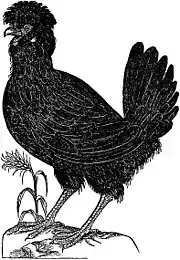Padovana chicken
The Padovana or Padovana dal gran ciuffo (lit. 'large-crested Paduan') is an ancient Italian breed of small crested and bearded chicken. It originates in, and is named for, the city and surrounding province of Padua, in the Veneto region of north-eastern Italy. Despite continuing discussion surrounding its true origins, it is recognised in Italy as an indigenous Italian breed.[3][4][5]
 | |
| Conservation status | |
|---|---|
| Other names | Padovana dal gran ciuffo |
| Country of origin | Padua, Italy |
| Traits | |
| Weight |
|
| Skin colour | white |
| Egg colour | cream to light brown |
| Comb type | none |
| Classification | |
| Notes | |
| crested breed | |
| |
History
The early history of the Padovana is unclear, and the subject of continuing discussion, as is its relationship to the Polish and the Dutch crested (Hollandse Kuifhoen) and Dutch bearded crested (Nederlandse Baardkuifhoen) breeds, which are variously considered to have originated in the Netherlands, in Poland, in Russia, or elsewhere.[4][6][7] It is often reported that the Padovana was brought from Poland to Italy by the "Marquis" Giovanni Dondi dell'Orologio (1330–88).[3][8] However the Dondi who was ennobled was the soldier Francesco Dondi, created Marquis by King John III Sobieski in 1676; no journey to or contact with Poland by Giovanni Dondi in the fourteenth century is documented.[9]
Two sources provide evidence of crested chickens in Europe in Roman times: the two marble statuettes of crested chickens observed in the Sala degli Animali of the Vatican Museums in 1927 by Alessandro Ghigi date from the first or second century AD;[10] a chicken skull excavated at West Hill, Uley, in Gloucestershire in England, shows the typical cerebral hernia of the crested breeds and dates from the fourth century.[11]
Early iconographic evidence of the breed in Padova is the fresco of the Annunciation by Jacopo da Verona, painted in 1397 in the Oratorio di San Michele in Padova, which shows a peasant woman feeding a crested hen and her chicks.[12]
The Padovana is described and illustrated as gallina patavina, or Paduan hen, by Ulisse Aldrovandi in the second part of his work on ornithology, Ornithologiae tomus alter cum indice copiosissimo variarum linguarum, published in Bologna in 1600.[13]: 310–311
In the twenty-first century, breed numbers remain low. A study published in 2007 used a figure of approximately 1200 for the total breeding stock, of which some 300 were cocks.[14]
Characteristics
Nine colour varieties are recognised for the Padovana, of which six are well-known and documented in older treatises: white, black, silver-laced, gold-laced, buff-laced and "sparrowhawk". The skin is white and the legs slate-coloured or black.[15]: 54 The comb is absent and the wattles vestigial; the ear-lobes are small, whitish and completely covered by the crest. Average weight is 1.8–2.3 kg (4–5 lb) for cocks, and 1.5–2.0 kg (3.5–4.5 lb) for hens. The eggs vary from cream to light brown, and weigh some 50–60 g.[8]
 | | | |
| Padovana cock and hen from Ulisse Aldrovandi, Ornithologiae tomus alter, 1600. | |
References
- Barbara Rischkowsky, Dafydd Pilling (editors) (2007). List of breeds documented in the Global Databank for Animal Genetic Resources, annex to The State of the World's Animal Genetic Resources for Food and Agriculture. Rome: Commission on Genetic Resources for Food and Agriculture, Food and Agriculture Organization of the United Nations. ISBN 9789251057629. Archived 23 June 2020.
- Breed data sheet: Padovana / Italy (Chicken). Domestic Animal Diversity Information System of the Food and Agriculture Organization of the United Nations. Accessed June 2023.
- Zanon, Alessio Padovana (in Italian) Il Pollaio del Re. Accessed January 2012.
- Atlante delle razze di Polli - Razze italiane: Padovana (in Italian) Accessed January 2012. "Atlas of chicken breeds - Italian breeds: Padovana".
- FIAV (1996) Standard Italiano delle razze avicole (in Italian). Casatenovo, Lecco: Tipografia Artigiana.
- History of the non bearded Polands Nederlandse Kuif en Baardkuifhoenderclub. Accessed January 2012.
- Luuk Hans, Stefano Bergamo (translator) Sulle tracce di Aldrovandi (in Italian) Federazione Italiana Associazioni Avicole. Accessed January 2012.
- Progetto CO.VA. – Interventi per la Conservazione e la Valorizzazione di razze avicole locali Venete (in Italian) Veneto Agricoltura: Azienda Regionale per i settori Agricolo, Forestale e Agro-Alimentare. Accessed January 2012.
- Franco Holzer (2009). Le ricerche d'archivio riguardanti la famiglia Dondi dall'Orologio (in Italian). Accessed January 2012.
- Alessandro Ghigi (1942). Genetica e morfologia dell'ernia cerebrale di alcune razze di polli (in Italian). Commentationes. 6, part 1: [223]-383. In Civitate Vaticana: Pontificia Accademia delle Scienze.
- Don Brothwell (1979). Roman evidence of a crested form of domestic fowl, as indicated by a skull showing associated cerebral hernia. Journal of Archaeological Science. 6 (3, September 1979): 291–293. (subscription required).
- Franco Holzer (2009). La gallina Padovana dal gran ciuffo era presente a padova nel XIV secolo (in Italian). Accessed January 2012.
- Ulisse Aldrovandi (1600). Ornithologiae tomus alter...cum indice copiosissimo variarum linguarum (in Latin) Bononiae: apud Io. Bapt. Bellagamba.
- A. Spalona, H. Ranvig, K. Cywa-Benko, A. Zanon, A. Sabbioni, I. Szalay, J. Benková, J. Baumgartner, T. Szwaczkowski (2007). Population size in conservation of local chicken breeds in chosen European countries – Populationsgrößen in Erhaltungszuchtprogrammen für einheimische Hühnerrassen in ausgewählten Ländern Europas Archiv für Geflügelkunde 71 (2): 49–55. Stuttgart: Eugen Ulmer. ISSN 0003-9098.
- M. Ferasin, A. Candian, S. Sisto, A. Scudeller, L. Causin, N. Ormenese, E. Burigana, S. Zuanetto (2006). Carni e frattaglie fresche e loro preparazione, parte prima (in Italian). In: Atlante dei prodotti tradizionali agroalimentari del Veneto, pages 25-71. Veneto Agricoltura. Accessed January 2012.